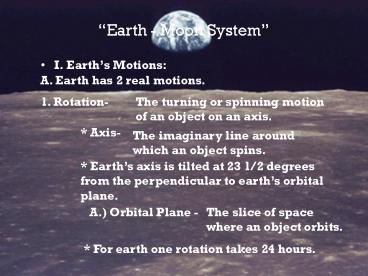Earth Moon System - PowerPoint PPT Presentation
1 / 18
Title: Earth Moon System
1
Earth - Moon System
- I. Earths Motions
A. Earth has 2 real motions.
1. Rotation-
The turning or spinning motion of an object on an
axis.
Axis-
The imaginary line around which an object spins.
Earths axis is tilted at 23 1/2 degrees from
the perpendicular to earths orbital plane.
A.) Orbital Plane -
The slice of space where an object orbits.
For earth one rotation takes 24 hours.
2
The circling of one object in space around
another object.
- 2. Revolution-
Earth revolves around the sun at 107,826 Km/hr.
Earths average distance from the sun is 93
million miles or 150 million kilometers.
Aphelion -
When earth is farthest away from the sun.
1.) July 4th furthest away. 152 million km.
Perihelion -
When earth is closest to the sun.
1.) January 3rd closest to the sun. 147 million
km.
For earth one revolution takes 365.25 days.
1.) There is a leap every 4 years, makes up for
the .25 days.
3
Earths Seasons
- A. Why does earth have seasons?
- B. Seasonal Dates
1. Spring Equinox or Vernal Equinox
March 20/21
First day of spring.
Hours of daylight are the same in both
hemispheres.
4
2. Summer Solstice
(Latin for The Sun Stands Still)
June 21/22
First day of summer.
North Pole is tilted toward the sun.
Longest hours of sun light in the Northern
Hemisphere.
Suns direct rays are on the tropic of cancer.
(23 1/2 degrees North Latitude.)
Continual Arctic Circle day light.
Called land of the midnight sun .
5
3. Fall Equinox or Autumn Equinox
September 22/23
First day of fall.
Hours of day light are the same in both
hemispheres.
6
4. Winter Solstice
December 21/22
First day of winter.
North Pole is tilted away from the sun.
Shortest hours of sun light in the Northern
Hemisphere.
Suns direct rays are on the Tropic of
Capricorn.
(23 1/2 degrees South Latitude.)
Continual Arctic Circle darkness.
7
The Moon
- I. Moon Characteristics
A. Moons Rotation and Revolution
1. Moons Rotation Its Revolution.
2. This is why the same side of the moon faces
the earth at all times.
3. 29 1/2 days to travel around the earth.
B. Moon Structure
1. Craters cover the surface.
2. First thought to be volcanic craters.
3. Now we know that meteorite impacts caused
them.
8
4. Rays-
Cracks extending out from craters. Caused by
violent meteorite impacts.
5. Maria-
(Latin for seas or oceans) Low areas of dark soil
where ancient lava flows covered the surface.
6. Marias were first thought to be seas or oceans
by early astronomers.
7. The moon also has mountains as large as any on
earth.
9
- II. Phases of the moon
A. The moon takes 29 1/2 days to complete all of
its phases.
B. Phase Shapes
1. Crescent -
Banana shaped.
2. Quarter -
Half-moon.
3. Gibbous -
3/4 of a circle.
4. Full -
Complete circle.
5. New -
Not visible.
C. Phase Stages
1. Waxing means to become brighter. New to full
moon.
2. Waning means to become dim. Full to new moon.
10
D. The Phases of the Moon
1. New Moon
2. Waxing Crescent
3. 1 st Quarter
1
2
3
4. Waxing Gibbous
5. Full Moon
4
5
6
6. Waning Gibbous
7. 3 rd or Last Quarter
8. Waning Crescent
7
8
9
9. New Moon
11
- III. Eclipses
A. Eclipse-
The passing of one object into the shadow of
another object.
B. Total Eclipses -
When the object is fully eclipsed.
1. The eclipsed object must be completely in the
umbra of the other object.
2. Umbra -
The complete inner shadow of an object.
When the eclipsed object is partially in the
umbra and partially in the penumbra of the other
object.
C. Partial Eclipses -
1. Penumbra -
The partial shadow of an object.
12
D. Lunar Eclipses
1. The full moon is in the earths shadow.
2. Approx. 2hrs. In length.
3. More often seen than solar eclipses.
Total Lunar Eclipse
penumbra
umbra
penumbra
Partial Lunar Eclipse
penumbra
umbra
penumbra
13
E. Solar Eclipses
1. The earth is in the shadow of the new moon.
2. Length from 4 - 8 minutes.
3. Less often observed than lunar eclipses.
4. Very bright, dangerous eclipse.
5. Never look directly at it.
6. Brightest part of the sun (the corona) can be
seen. (Will permanently damage the eyes.)
Full Partial Solar Eclipse
penumbra
umbra
penumbra
14
- IV. The Moons Origin
A. Possible theories of origin
1. Formed when earth did. (Possible)
2. Captured by earth.
3. Impact theory.
Something half the size of earth strikes it,
sending molten materials into space.
Molten material solidifies into the moon.
Planet Orpheus collided with earth to cause this.
15
2
3
1
4
5
16
- V. Tides
A. Tides- The periodic rise and fall of the
ocean due to the gravitational pull of the Moon
and Sun.
1.) When the ocean levels are highest it is
said to be high tide, and when they are the
lowest it is said to be low tide.
B. Tidal Range- Is the difference in water
level between high tide and low tide.
C. The moon effects tides more than the Sun
because it is closer to the Earth.
D. Because of this, the Sun either increases
the effect of the Moon or decreases the effect.
17
1.) Spring Tides- A tide of large range that
occurs during the new moon phase or full
moon phase.
The Sun increases the effect of the
Moon.
18
1.) Neap Tides- A tide of small range that
occurs during the 1st quarter phase or 3rd
quarter phase.
The Sun decreases the effect of the
Moon.































